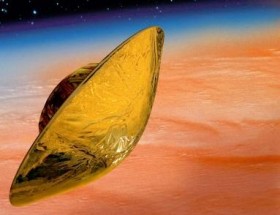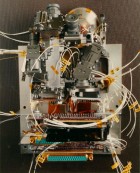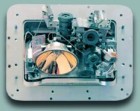Descent Imager / Spectral Radiometer (DISR)
Instrument of the Huygens probe onboard the Cassini spacecraft
 During the descent of the Huygens probe through Titan's atmosphere in January
2005, the Descent Imager / Spectral Radiometer (DISR) will take images and
perform measurements at various spectral ranges and spatial resolutions.
These will provide information about the composition of the haze layer,
the presence of methane cloulds and the nature of the surface.
During the descent of the Huygens probe through Titan's atmosphere in January
2005, the Descent Imager / Spectral Radiometer (DISR) will take images and
perform measurements at various spectral ranges and spatial resolutions.
These will provide information about the composition of the haze layer,
the presence of methane cloulds and the nature of the surface.
Science objectives
Saturn's moon Titan is the second-largest moon in the Solar System
after Jupiter's moon Ganymede, larger even than the planet Mercury -
and it is the only moon that has an atmosphere worth mentioning. On
the ground, Titan's atmosphere has one-and-a-half times the pressure
of Earth's atmosphere, and like it, consists mainly of nitrogen -
however, it contains neither oxygen nor carbon dioxide. Instead, it
comprises methane and possibly the noble gas Argon.
The temperature on the moon's surface is approximately -180 degrees
Celsius, which eliminates the possibility of liquid water. However,
methane can occur both in a gaseous and in a liquid state under these
conditions. Therefore, methane's role on Titan may be similar to that
of water on Earth - with a precipitation cycle involving clouds, rain
and evaporation. Lakes or even oceans of methane and ethane are
conceivable, but no one knows what Titan's surface actually looks
like, as it is hidden beneath an impenetrable, orange haze.
In the wake of the Voyager 1 flyby of Titan, several initiatives were
started to promote a mission to Titan. In 1997, the Cassini/Huygens
mission was launched, which has reached the Saturnian system in July
2004. The Cassini spacecraft will deliver the Huygens probe to Titan
in January 2005 and then explore the Saturnian system for four to ten years.
The Huygens payload comprises six instruments, five of which will
carry out measurements during the descent through the atmosphere
(starting at about 160 km altitude). One of these instruments is the
Descent Imager / Spectral Radiometer (DISR), which will take images
and spectral measurements in different directions at various spectral
ranges and spatial resolutions. The detectors of the DISR are a 512 x
256 CCD for the visible, two linear arrays of 132 photodiodes each for
the infrared and two photodiodes for the violet spectral range. Light
from the foreoptics of three surface imagers (high resolution, medium
resolution and side looking), two visible spectrometers (upward and
downward looking) and the Solar Aureole Imager (SA) is conducted by
fiber optics to the CCD.
![[Top]](/images/icons/top.gif)
DISR instrument description
 The DISR experiment consists of a sensor head box (SH) conducting
the optics and the related detectors and of a separate electronics
assembly (EA) box connected by a cable (
The DISR experiment consists of a sensor head box (SH) conducting
the optics and the related detectors and of a separate electronics
assembly (EA) box connected by a cable (
 View of the instrument from above
during assembly, optical fibres not connected, without cover)
The View of the instrument from above
during assembly, optical fibres not connected, without cover)
The  SH
is located on the experiment platform of the Huygens entry probe at a
jettisonable cover such that it will be exposed to Titan's atmosphere
with an unobstructed view upwards and downwards. It is an optical
assembly containing 11 independent scientific data functions. SH
is located on the experiment platform of the Huygens entry probe at a
jettisonable cover such that it will be exposed to Titan's atmosphere
with an unobstructed view upwards and downwards. It is an optical
assembly containing 11 independent scientific data functions.
Measurements are made in the visible wavelength range and in the infrared.
Most data at visible wavelengths will be collected by a
 CCD
imaging detector, where each CCD pixel is permanently assigned to a
certain data function. Thus, no complex mechanisms are needed to
reconfigure the instrument to collect different data.
This CCD detectector is a contribution of MPS.
In addition, two simple violet
radiometers looking up resp. down, each consisting of a PIN diode and
a filter, are included. For infrared measurements, a single grating
spectrometer is used which is equipped with two linear focal plane
detector arrays consisting of InGaAs diodes. They are supported by CCD
multiplexers. This component has been developed at CCD
imaging detector, where each CCD pixel is permanently assigned to a
certain data function. Thus, no complex mechanisms are needed to
reconfigure the instrument to collect different data.
This CCD detectector is a contribution of MPS.
In addition, two simple violet
radiometers looking up resp. down, each consisting of a PIN diode and
a filter, are included. For infrared measurements, a single grating
spectrometer is used which is equipped with two linear focal plane
detector arrays consisting of InGaAs diodes. They are supported by CCD
multiplexers. This component has been developed at
 DESPA,
Observatoire de Paris. A small shutter permits a digital form of
synchronous detection and a high signal-to-noise ratio. DESPA,
Observatoire de Paris. A small shutter permits a digital form of
synchronous detection and a high signal-to-noise ratio.
 Inflight calibration is performed by means of optical fibers
connecting all subsystems to a single calibration source (three 1 W
tungsten halogen lamps). The main optics and the sensors are mounted
on a titanium support frame. Cooling of the device is achieved by
conducting heat from the detectors to the ambient Titan
atmosphere. Small heaters will stabilize the detector temperature at
about 185 K.
Inflight calibration is performed by means of optical fibers
connecting all subsystems to a single calibration source (three 1 W
tungsten halogen lamps). The main optics and the sensors are mounted
on a titanium support frame. Cooling of the device is achieved by
conducting heat from the detectors to the ambient Titan
atmosphere. Small heaters will stabilize the detector temperature at
about 185 K.
The CCD array is divided in nine areas: three are used for the imager (downward looking in the visible and the IR channel, outward looking), four for measurements of the solar aureole at two wavelengths and two polarization angles, and two for the IR measurements (upward and downward looking spectrometers). The CCD was developed under contract of MPS at Loral in Tustin, Ca. It is is a high-resolution 2 phase frame transfer CCD with implied electronic shutter function so that no mechanical shutter is required. The size of the detector (512 x 256 pixels) is well adapted to the data transmission capability since all derived data must be immediately transferred to the Cassini orbiter.
The key functions of the electronics assembly are:
- power supply
- electric interface to the spacecraft
- housekeeping measurements
- detector drivers
- signal processors
- microprocessor and memory
- image compressor
while the sensor head contains only the part of the electric circuitry
directy related to the detectors.
The instrument will consume about 15 W excluding the surface science lamp and the hardware data compressor which allows an on-line 6:1 compression of the image data within 750 ms and which will only be switched on for short time intervals.
![[Top]](/images/icons/top.gif)
MPS contribution
The scientists working on DISR at the MPS are
- Horst Uwe Keller (DISR co-investigator, project lead at MPS)
- Jörg-Rainer Kramm
- Björn Grieger
- Yuri Skorov
- Stefan Schröder
The MPS was responsible for development, qualification and pre-calibration of the CCD detector and its associated operation electronics. The image compression board was developed in co-operation with the Technische Universität Braunschweig, Institut für Datenverarbeitung.
In the scientific analysis of DISR data, the MPS focusses on investigating the aerosol distribution in the atmosphere and the materials on the surface of Titan.
![[Top]](/images/icons/top.gif)
Cooperation Partners
![[Top]](/images/icons/top.gif)
Related links
|
